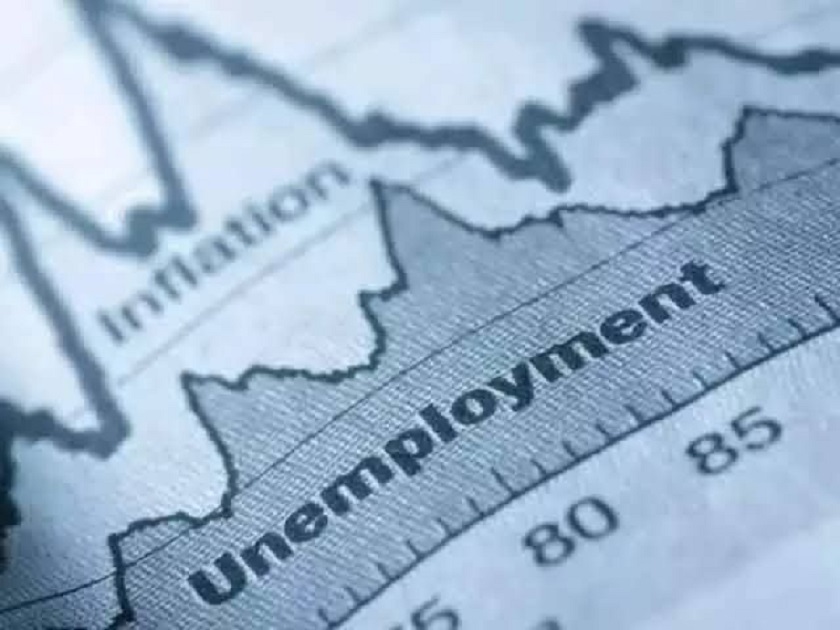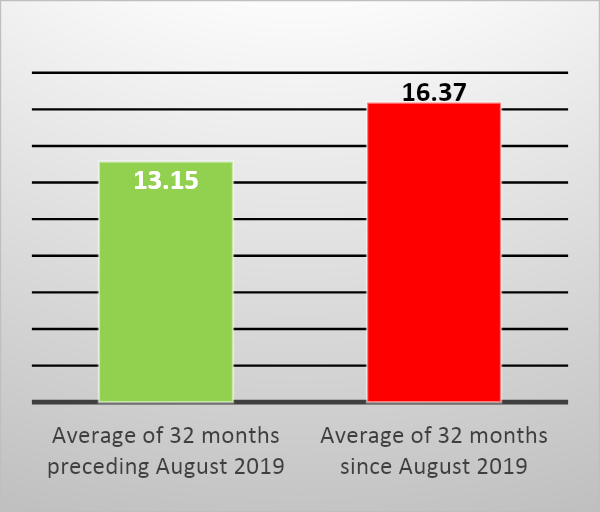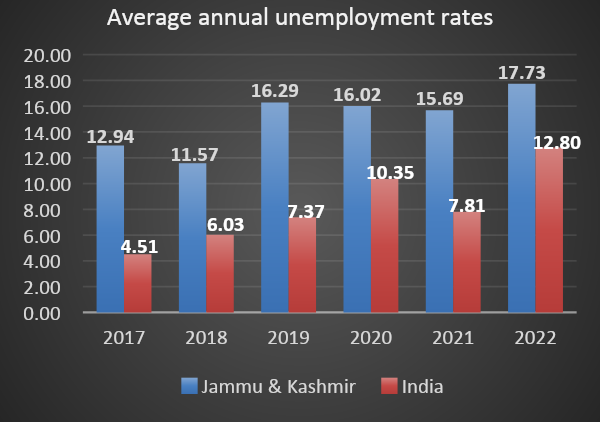
IF there is one example in modern history as to how devastating economies result in widespread human sufferings, it’s the Great Economic Depression of the 1930’s. It began in the United Stated and spilled over to rest of the world for the good part of that decade. 24 percent unemployment recorded in the US during the depths of the Great Depression in 1930’s is still considered as the worse that could happen when economic policies collapse at a lethal pace. J&K is currently standing at 25% as per Centre for Monitoring Indian Economy (CMIE). That’s roughly over 1.1 million jobless people. Another credible Labor survey report which substantiates the chronic unemployment scenario in the region was published by Union Ministry of Statistics and Programme Implementation for April-June 2021 period. J&K registered a staggering unemployment ratio of 46.3 percent (15-29 age group urban). One can only wonder, if these dystopian unemployment figures qualify declaring J&K’s economy under a great depression. The situation as per data appears beyond alarming.
How did we reach here?
The time series data on unemployment published by CMIE with monthly frequency throws some obvious but very alarming patterns. A superficial look at the data shows that the average unemployment rate after August 2019 political lockdown till March 2022 for a period of 32 months is much higher i.e. 16.37 percent, which is 322 Bps higher when compared with the average unemployment rate of only 13.15 percent registered for the same period preceding the August 2019 lockdown.

No doubt the frequent lockdowns on account of the pandemic did extend the pain for an extended period, however, the downfall in job market started much before Covid started engulfing the economy. As can be seen from the average annual unemployment numbers, the biggest year-on-year jump in unemployment was witnessed in 2019 from 11.57 percent to 16.29 percent. Since then, there has been no respite in the region’s job scenario. The first three months of the calendar year 2022 have opened on a very steep trajectory with average unemployment touching 17.73 percent already.

After agriculture, the biggest employment provider in J&K is the trading sector with roughly 10 lakh people deriving their livelihood from this systemically significant sector. This is approximately a quarter of the region’s workforce. The series of lockdowns on account of Covid19 and August19 gave a lethal shock to the demand, which in turn resulted in massive layoffs. Job losses further contracted the average household income creating a downward spiral in spending and consumer demand. The spillover effect engulfed other sectors resulting in a serious contraction of the region’s economy. Manufacturing and transport sectors which collectively create around 5 lakh jobs also suffered massively on account of demand slump and supply chain bottlenecks. Besides lockdowns, a series of myopic policies like introduction of GeM portal by the Govt. exposed the local industries to unaffordable risks leaving a majority of them out of business. To add insult to the injury, global slowdown on account of Covid19 and geopolitics dented the very essential conduits of foreign exchange from exports and foreign remittances. This stressed a huge workforce of over 3 lakh artisans. Construction and Govt. sector are the only two sectors which remained resilient and supported the local economy during these economically testing times.
What has been the policy response so far?
With a dead tired consumption, exports, and private investment scenario, the Govt. as the only response has been amping up its public spending through annual budgetary provisions. So far, we have seen plenty of intentions and announcements, however, the efficiency of delivery has been a very disappointing experience. In addition to this, the Govt. has tried to push banks in extending credit in order to catalyze the recovery, however, the stressed balance-sheets of the banks find it very difficult in assuming more credit risk. The annual credit growth in J&K when compared to previous financial years has been quite dismal, which speaks volumes about the reluctance of Banking industry in burning its fingers further in this economically turbulent environment. The focus is instead on recoveries which is the last thing the already starving borrowers expected right now.
In addition to public spending and bank credit, the Govt. has been trying to woe foreign investors very aggressively. Although a series of announcements regarding investments secured from UAE based business houses made it to the headlines, however, the impact of these significant economic goodies may be expected in medium and long term. Instead, the problems of unemployment are immediate, urgent and unaffordable and therefore require a short-term, result oriented and an inclusive response.
There is a famous quote by William Shakespeare, “You take my life when you take the means whereby I live.” Unemployment is a social issue which is rapidly branching out to ugly socio-economic problems like poverty, drug abuse, suicides, social unrest, mental health and crime. It is therefore essential and extremely urgent that a multipronged short-, medium- and long-term policy is adopted for addressing this unaffordable problem. We hope systemic forces like peace and pandemic too align with the policies and facilitate the path to recovery, so that J&K comes out of this grim economic situation swiftly.
Views expressed in the article are the author’s own and do not necessarily represent the editorial stance of Kashmir Observer
Follow this link to join our WhatsApp group: Join Now
Be Part of Quality Journalism |
Quality journalism takes a lot of time, money and hard work to produce and despite all the hardships we still do it. Our reporters and editors are working overtime in Kashmir and beyond to cover what you care about, break big stories, and expose injustices that can change lives. Today more people are reading Kashmir Observer than ever, but only a handful are paying while advertising revenues are falling fast. |
| ACT NOW |
| MONTHLY | Rs 100 | |
| YEARLY | Rs 1000 | |
| LIFETIME | Rs 10000 | |











